#she is a greater racket-tailed drongo
Explore tagged Tumblr posts
Text
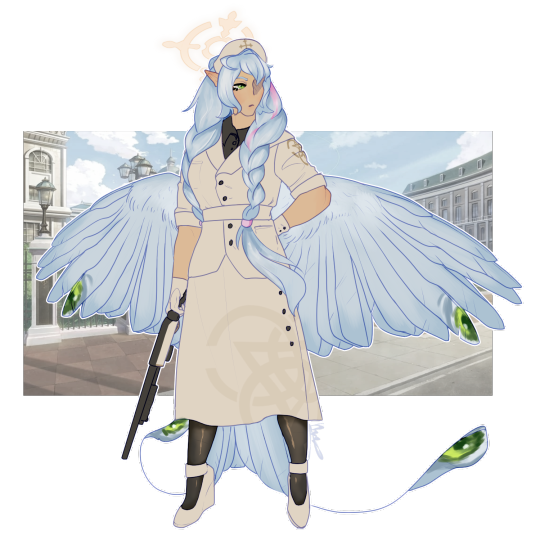
crawling out the other end of a month inactivity with media i have a love-hate relationship with (do not ever look at the media tag)
#blue archive#aomori mine#she is a greater racket-tailed drongo#the eye spots are homage to higher-ranking angels
7 notes
·
View notes
Text
Bright Clan leader concept

Here is what I imagined the leader of the Bright Clan would look like. I wanted her to look well elegant in a way.
Size comparison on the left: SC (Shadow Clan, average one, not the leader), BC (Bright Clan), And H (Human).
She has three tails but only the big one in the middle has a hand she can use to sling slugs.
The Name
Originally her name was gonna be Selehadin because it's a pretty-sounding name, but that name means The Righteousness of the Faith.
And I wanted a name that meant light, bright, illuminate, etc. And it has to be of Middle Eastern origin.
So, I got stuck on three names for her:
Alamafruz means Enlightener of the world.
Mashaal means Light, bright, etc.
And Ilknur means First Light.
The images that inspired her look:
(Keep in mind that I don't own any of the images below)
Halime dress, just the headdress
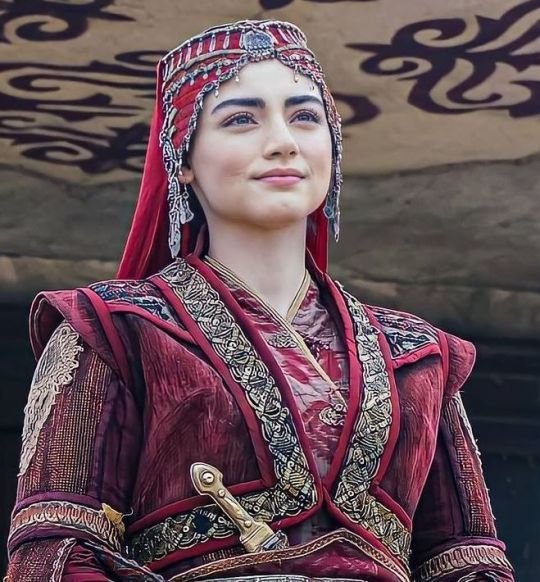

Arabic calligraphy
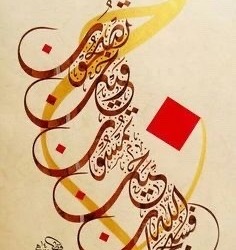

Scarf top

Greater Racket-tailed drongo
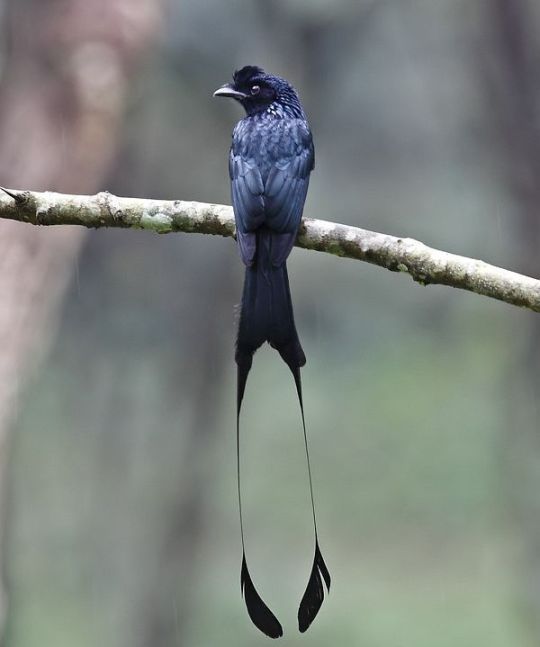
And that's all folks!
47 notes
·
View notes
Text




meet the card reader .

hello ! i ' m ollie , or moon , and this is a bit about me .
basics :
✩ i 'm indian ( nationality ) but i live in canada . i use any pronouns with a preference for they/them ( although i don ' t mind she/her , he/him , or neos ) and am lesbian ! ✩ i ' m audhd and i have quite a few mental disorders so please be patient with me . my mtbi type is intj - t ( the architect ) . ✩ my birthday ' s october 15th . i have yet to find my birthday twin . ✩ i write for fun . i won ' t post every week , only when i have the motivation to do so . ✩ i don ' t have to respond to your asks if i want to . do not spam me . ✩ english is not my first language (grammerly save me) ✩ i am a minor !
fandoms :
✩ i have a bunch of fandoms i ' m in !! ask me for one i ' m probably in it . i have a bunch of kins , but my main ones are hawkfrost and moth flight from warrior cats . i ' m so normal about them .
misc :
✩ therian ! ( vancouver coastal sea wolf , maned wolf , crow , greater racket-tailed drongo, otter, canadian lynx ) . ✩ silly :3 ✩ read more about me here !
DNI :
✩ heavy nsfw ( light / suggestive stuff okay ) ✩ zionists ( no politics in gen ) ✩ no zoophs / proshippers ect . keep it off my page . ✩ no vent / trauma dumping unless you have asked beforehand . ✩ please use tone tags / indicators ✩ be nice ( please )

#caitlyn kiramman smut#caitlyn kiramman x reader#arcane x reader#vi x reader#warrior cats#arcane x you#warriorcats#caitlyn arcane#arcane x female reader#caitvi x reader#wc#warriors#wings of fire#jurassic world#wildlife#writing#writers on tumblr#wlw#um#hi
17 notes
·
View notes
Text

Decided to challenge myself by drawing every single TLK character out there, up until this point in time, and post it here. You can see the finished project on my main account, though I figured to post it on my tumblr just show I could proudly show off my work and a few of my head canons.
Here's part two of all the non-raptor birds across TLG/K:
Starting strong with the egrets we have Ono/Maono(vision). The last of the Guard members to be featured here, though hardly due to lack of interest. I do like Ono, for how know-it-all and blunt he can be, I do see the appeal in his respectful and pragmatic nature, plus seeing him in his arc in the third season. He eventually becomes the Night Pride's majordomo/scout for the Day Guard, filling in for the time of day when Rani and her group are asleep and Kion and his team are awake. Ono, like myself, if also ace-aro, so while he doesn't get into a relationship or fathers any children, one day, who should come to the Tree of Life but a pair of hamerkops, none other than Ona/Kuona(sight) and mother Kulinda(protect), and he does take on a fatherly-uncle type role with Ona, as well as another egret.
Next up is what I like to call the secondary TLG characters category, composed of Tamaa(appetite) the drongo, Mwenzi(partner) the red-billed tickbird, and the yellow wagtail, featured in "Beshte and the Hippo Lanes", Nyuni(the bee). For all my gripes with TLG's design and story choices, I will say that their bird designs are pretty consistently decent across the board, even if Tamaa's design resembles the Asian-native greater racket-tailed drongo instead of a more geographically appropriate fork-tailed drongo, as I've portrayed here. I did also notice that there was a female yellow wagtail, so I made her Nyuni mate and her name is Mbila(millet). Also Bupu and Kifaru make very small cameos here.
I was really surprised to find out TLK doesn't have a lot of flamingo characters. Sure they appear in quite a few comics and stories, though counting named characters and ones we see in TLG, mentioned in the TLK wiki no less, that gives us about three actual characters. So I added on two more to the ones we got. Also Africa is home to two species of flamingos, the greater and lesser species, which in my research is more just size rather then quality, though the really bright flamingos you think of when seem to be more an American/Caribbean species. Still, considering that flamingos get their pink feather coloring from crustaceans, and the more they eat the more pink they are, I'm just gonna say that the seafood/algae in TLK/G for the most part is extremely rich in carotenoid. You can pry my Barbie pink African flamingo designs from my cold dead hands.
First off are TLG's Flamingo girl 1/Fuari(happy) and Flamingo girl 2/Juisi(juice), named after two of my favorite songs. They're greater flamingos and both of them live in their flamboyance next to Azaad's territory, often becoming his meal. I imagine flamingos, while native to most of Africa where there's water, are an uncommon sight for many, though are very adored for their perky pink plumage and fabulous, flamboyant festivities. For the other flamingo character before we get to the unnamed ones we have Yeye(she). She is leader of the greater flamingos in the Pridelands, specifically at Lake Kidogo. She is also considered a bit overdramatic, as she and her fellow flamingos once nearly declared war on Kiboko and the hippopotamuses for their less kempt nature/appearances, though in fairness Kiboko was being an extra big jerk, though he alone would've made pink morsels out them realistically. I based her design off the ones glaring at Kovu before his exile in TLK2.
The last two flamingos didn't have names, but considering I'm a big fan of flamingos and we definitely needed more, here you go. First off is the one we see from "A Kinglike Hair-do" I've named Sabuni(soap), yet another song I like. While walking down with his vain monkey friend Isimo, Simba and him come across a flock of flamingos, which Isimo argues about how pretty can they really be compared to him and decides to spook them by running through them. Simba then noticed Sabuni, injured and realizes her flock was trying to protect her. Simba calls the rest of the flock back, promising not to harm any of them, and they are able to go back to their injured friend, who eventually recovers. This event would make the flamingos have a more positive outlook towards Simba later on when he set about restoring the Pridelands back after Scar's reign, making them easy support. Later in the comic the flock plus a lemur Simba helped earlier save him from a snake-infested river.
Fataki(fireworks) is the last of the flamingos, and last one named after songs I like. From "Pretty in Pink", he is the only male on this list, and is the leader of a flamboyance of lesser flamingos who take over a small pond in the Oasis during a dry spell, peeving off our Hakuna Matata trio and anyone else hoping to use the pond for cooling off. The trio decide to infiltrate the pond by painting themselves pink with berry juice and gathering fallen flamingo feathers to try and trick the flamingos into allowing them to enter, though the plan fails when they topple into the water and wash away their disguise. However before they can get pecked for their trickery, Pumbaa emerges from the mud the sight of him is so frightening that the flock flees, allowing the trio to cool off in peace. Since then the flock has avoided that specific pond in fear of the 'mud monster' that appeared before them, though still are pretty selfish and vain still.
So at this point you already know my penchant for making these lists increasingly harder for myself. TLG has a long list of bird species that they've shown or used for a line or two, but are never given proper names, just barely a wiki page if they're lucky. The next five characters do have a TLG wiki page yet no specific names. After that, I decided that the other bird designs in TLG were too good to waste, so they will be given a brief mention and name.
Starting off with the unnamed characters which mostly come from "Friends to the End", we have the peacock leader of his flock, now a congo peafowl, Shabiki(fan). Congo peafowl are technically peacocks in Africa, but are much more subdued and don't nearly have as much pizzaz with their tail feathers as your typical Indian variant, and neither are nearly as stunning as the green peafowl... fight me. They've got eyespots all over, not just their tail feathers.
Next we get some waterfowl, starting with the former barnacle geese Mother goose/Ndege(fowl), now an African goose, and her son Jirgi(flight-Hausa) and daughter Gurbi(nest-Hausa) from "Friends to the End". So with barnacle geese, apparently they create nests on high cliffs to avoid predation, however within a few days of hatching goslings must jump off these cliff faces in order to meet their parents who are foraging on the grass below, which is what we learn in TLG, however I have no knowledge of African geese doing the same. However given how rude she was, in my 'verse the chicks did fall off a cliff where their mother had decided to build their nest on top of, and was too prideful to admit she was in the wrong. She later becomes food for Makucha's Army, though her chicks thankfully make it to adulthood relatively unscathed.
Last of the waterfowl is the African black duck from "The Search for Utamu" that Fuli saves her nest from some fighting oryxes. Her name is Bata(duck) and given that her species can have 4–8 eggs at a time, I like to think she named one after Fuli. Their design was pretty nice, though I changed the orange bill/beak to the original's black, though I imagine the reason why they originally had it orange was to help with figuring which part to animate.
Now for the unnamed, background species from TLG. These guys were already enough work to figure out how to make that they'll just get a brief excerpt.
White-throated laughing thrushes: Safisha(tidy). Their colors in the show just seemed to be extremely saturated, so I mellowed them somewhere between their real-life and cartoon counterparts.
Common Kingfishers: Choraji(painting). They're only found in a TLG "Look and Find" book, though still included because... well just look how pretty they are.
Great blue turaco: Mkweli(truthful) and white-crested turaco?: Mchele(rice). Such beautiful blue feathers for the former, absolutely stunning. For the white-crested turacos, for some weird reason in the show they made them... so weird. Like they took a blue-crested turaco and used pastel colors, baby blues and creams.... so I used the real-life design here. Perfectly colorful and serviceable design, I don't know what TLG was planning, though in my book these two are happily married to one another.
Grey-Headed Tanagers: Eji(dew-Yoruba). Another really-saturated cartoon design, though I honestly was doubting whether or not it was a tanager and not a sunbird or superb starling, or even if it was meant to be a variant of the grey-headed bushstrike they've already made. However it did get to a point where looking up species was starting to not be fun, so I conceded in the end, but did mute the colors more.
Grey-Headed Bushshrikes: Pazia(veil). Not much to say, but a really good design overall, for both real-life and TLG.
Southern red bishop: Kivara(clothing). Technically put under the finches wiki page, though the Southern red bishop is actually part of the weaver family, though stunningly beautiful nonetheless.
Peach-faced lovebird: Koro(heart). A cutie patootie, him and Kivara are mates too.
Green bee-eaters: Limu(lemon) and blue-throated bee-eater: Dubaku(look). The blue-throated bee-eater is an Asian species, so it's swapped with a blue-headed/mustached bee-eater here. I also had to work with the green bee-eater design a bit, since it seems TLG based it more off the Asian green bee-eater and not off the African one, which is slightly less flashy then the former.
White-necked ravens: Mlio(crow). It seems a bit weird to put a raven here, though like the peregrine falcon, apparently they too are found all across the world minus Antarctica and weirdly South America too. Hmm, well anyways I think they are very beautiful.
Lastly is Binti the hornbill, a yellow-billed oxpecker here and you can read more about her story here, as well as why this deleted love interest for Zazu is apparently a tickbird and not a hornbill. I did give her a slight redesign and that will apply to all the unnamed chicks which I did not bother to redo here, but I feel like she has a good design for the last character on this sheet.
#african birds#lion king#lionkingchallenge#art challenge#charcater design#character design#lion guard#flamingo#egret
5 notes
·
View notes
Text
Kanha - 5
Safari 3: Kisli Zone (Morning)
At 6 am we board the Gypsy for the morning safari. We are heavily dressed for the biting cold. We are particularly grateful for the balaclava (that was purchased in 2012 in downtown Leh while shopping for the EBC trek but hadn’t been used ever) that protects us from the swirling mist and freezing air that are out to get us in the general grogginess of pre-dawn darkness.
The silence of our drive on the bumpy road is shattered by shrill cries that suddenly fill the air. We halt the Gypsy. The cries seem to be coming from the thicket on the left. We manoeuvre the Gypsy and turn on the powerful lights to spot a pair of deer frantically bellowing out the alarm call. They look visibly scared, their big wide eyes reflecting fear in the light. We study the surroundings that lie just outside the beams of light for movement. We go back a few yards and direct light towards the thicket again to see if we can spot the source of the distress. We go forward a few yards and repeat the exercise. The deer are still very alert but the tension has lessened. Alarm calls continue at less frequency and seem to be moving in a westerly direction. ‘Probably a big cat just passed by’, Mr. Ashu observes, explaining the scene for the first time. We realize that in the 3 minutes since we stopped, we are hardly breathing.
We are too caught up in the tense experience to even consider taking out the cameras. One would imagine that as onlookers we wouldn’t be deeply affected by the plight of the deer. However, the fear seems more visceral than vicarious. ‘It can be quite an experience to deal with the emotions that arise in the wild. Different people react differently. But one has to realize that there’s no preplanned malice by the hunter nor complex afterthought by the hunted. It’s just the way of the world,’ Mr. Ashu shouts over the steady rush of the wind as we speed along on the metaled road towards the park gate.

The sky is already brightening as we wait for our guide. We watch wistfully as other Gypsies enter the park while we wait. At last our man appears. He takes the back seat and we amble along. All the mist-laden pictures of Kanha that we had seen earlier do little justice to the actual view. The mist is especially dense on the water bodies. The scene is right out of a Hindi horror movie. We glide along the mist laden trails through numerous water bodies. Finally, we see the dark orange sun peeping out from behind distant trees. Despite the sun announcing its arrival, light is dim and the forest is swathed in a veil of thin wickedness. Visibility isn’t good and the forest is eerily silent. It is at times like these that the tiger makes an entrance.
We spot a little clearing by tall grasses where a family of deer are grazing. They are alert and from time to time lift their heads as if to scan the surroundings. Somewhere in the jungle, monkeys shriek. We sit tight in anticipation. A barasingha sounds an alarm. The deer look up again. The barasingha is joined by another. At regular intervals the calls keep coming. For maybe 3 minutes. ‘You can track a tiger’s movement by listening to the calls of other animals. Birds, monkeys, deer, barasinghas will all alert you to a tiger’s presence. The alarm calls precede a tiger’s presence and die down as the tiger moves on. Animals see a tiger and sound an alarm. The tiger then hides. The animals think the tiger is gone. So they stop their calls. Then the tiger reappears. And the alarm calls restart. In the jungle, animals only react to what they see. If they see the tiger, they call. If they don’t see the tiger, even if the tiger is right there hidden behind the bushes, they don’t call. They live in the present - very real-time and immediate’, our guide speaks in undertones.
The monkeys have stopped their ruckus by now. The deer have also relaxed and are moving further into the forest. We still sit in the clearing waiting till the alarm calls die down. The tiger seems to have moved on from this area. We follow the sounds. The sun continues to shine through tall trees, casting more shadows than light. Mr. Ashu and the guide scan the trail for pug marks. There are none. We climb uphill and meet a Gypsy going downhill that tells us that a tiger crossed their path moments ago. This is probably the same tiger that had set off the alarm calls. We proceed slowly till level ground all the while scanning the vegetation on the left. We come upon the bend on the trail and bump into 2 other Gypsies that are still. Everyone is craning their necks. Something’s happening ahead, excitement increases.

We see the white whiskers first. Then we see the stripes. A magnificent tiger gingerly appears from the left, stares at the waiting Gypsies, crosses the trail to the right. He is very relaxed, neither dazed nor in a hurry. He approaches a tree, looks up as if contemplating climbing it. He stands on his hind legs and clutches the tree with the front paws. He crosses the trail again and goes to the left. It stops to look at us from time to time. Our presence doesn’t scare or anger him. He continues to study the grass, lie down, yawn, and proceeds to leave his scent on the trail by rubbing his underside on the foliage. We think he’s also farting into the grass to leave behind his scent. ‘Like most predators, tigers mark their territories by leaving their smell behind. This is M1. This is not his usual territory. But of late, we have been seeing him here. He’s difficult to spot but has over time got used to all the attention. Earlier he was very fidgety and would disappear into the bushes on seeing the Gypsies. Now he’s more assured and relaxed. He’s new to this area but has been moving in these parts since some time, probably reconnoiterring the area before settling down. M1 is named so as he’s the eldest of the 4 cubs, M1 through M4. They are all the offsprings of T8,’ Mr. Ashu explains.

M1 is a nice name to have - simultaneously anonymous and a stand-out. It's a fully grown adult male - a big animal, probably more than 2 meters in length and more than a meter in height. We are surprised that he's not roaring, not growling, not baring his menacing fangs. We are surprised that he's letting itself be watched, clicked, commented on for such a long time. We follow it for maybe 200-250 meters. If the Gypsies give it more room who knows how far it's willing to walk straight on the track! The sun is stronger now, casting a bright yellow light that bounces off the shiny orange coat of M1. Alternating sun and shade paint M1 as an unreal ephemeral beast.
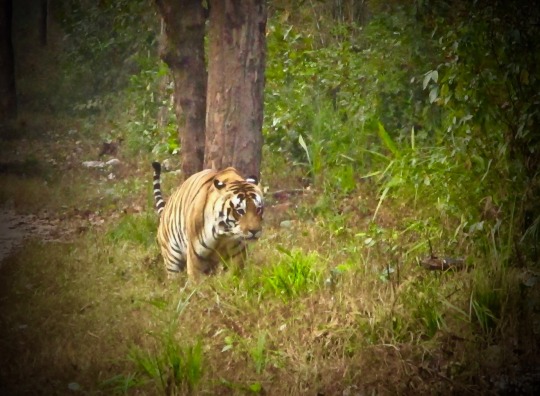
Our guide explains standing atop his seat for a better view of M1. ‘The tigress pushes the cubs away nearly after 2-2.5 years of birth. The cubs become a burden for the tigress around that time. She has to hunt almost daily if she has to feed her litter at 2 years. A single kill (depending on its size) can last a tiger from a couple of days up to a week. With cubs it becomes difficult to ration food. Once they are separated from their mother, the cubs figure out ways to hunt, establish territories, find partners to mate, etc. They also forget their mothers or siblings after a while. Except a young mother with cubs, it’s all about survival of the self.’ ‘Deer are the most frequent kill. Boars are a good kill but they require a lot of work. Munna used to steal cattle from neighboring villages’, he continues.
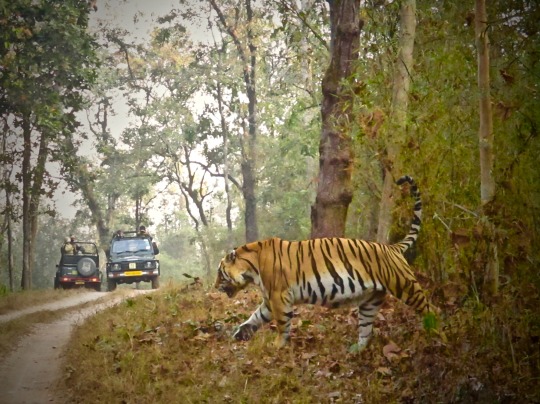
While M1 is calm personified, the Gypsies are restless. They are inching forward in low gear with restrained engines and excited tourists. All of them want to get close to the tiger. M1 senses this and stares up and down the trail. He acts cool but the noise is starting to get to him. He walks in the middle of the track for a long time, Gypsies at his tail. There are Gypsies on the other side too, delaying their departure to allow M1 to come as close to them as possible. M1 doesn’t mind the attention but he’s had too much of it now. He enters the thicket on the left and for a while walks alongside the trail before disappearing into the trees.
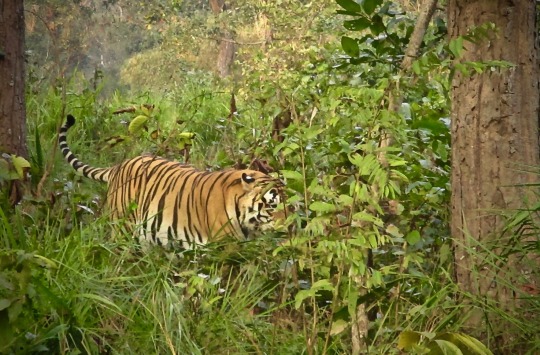
We speed away after M1 leaves. The rest of the safari is a blur after the high of M1. However, we remember a few things vividly. We spot a playful jackal couple in the sun close to the place we have breakfast at. Winter sun is pleasant for everyone - humans and animals alike. We marvel at the numerous streams and the bamboo bushes. We spot and click a lot of birds - parakeets, jungle babblers (also known as the Seven Sisters), oriental magpie robins, Indian rollers, kingfishers, woodpeckers, greater racket-tailed drongos, and black drongos. We sit for a long time under the trees listening to birds and trying to name them. It’s great fun. We learn a lot about birds from the guide and Mr. Ashu. Our appreciation of birds stems primarily from David Attenborough’s documentaries on Netflix. We spot a couple of tortoises with glistening backs that have surfaced in a pond to soak in the sun. An Indian cormorant is drying its wet wings next to them.

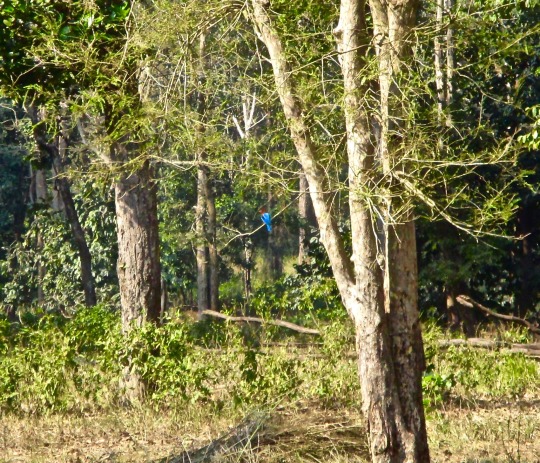
We are again climbing uphill when we hear alarm calls. Another tiger! The calls increase in frequency and seem to move in a tangential direction which we anticipate to be behind us and wait at the estimated point of crossing. However, the calls change direction and move away from us. The big cat seems to have changed its mind. We wait for a little while before proceeding towards the exit. It’s been a great day, and we are already thinking of documenting the day’s experiences before they fade away.
#Kanha National Park#Kanha#national parks#Indian jungles#wildlife#fauna#Indian wildlife#tigers#birds#forests#jungles#animals#M1
4 notes
·
View notes